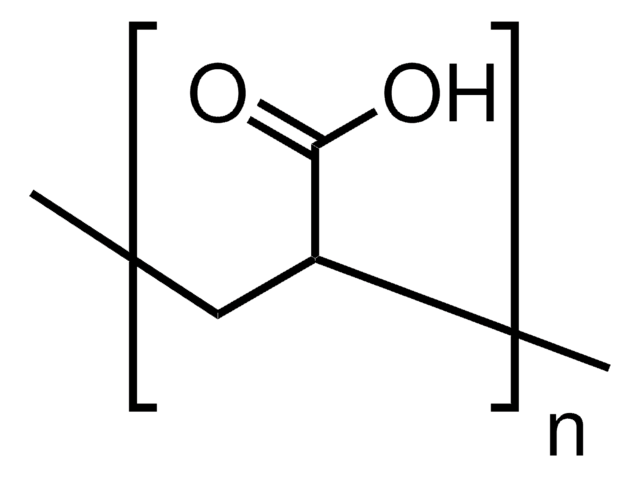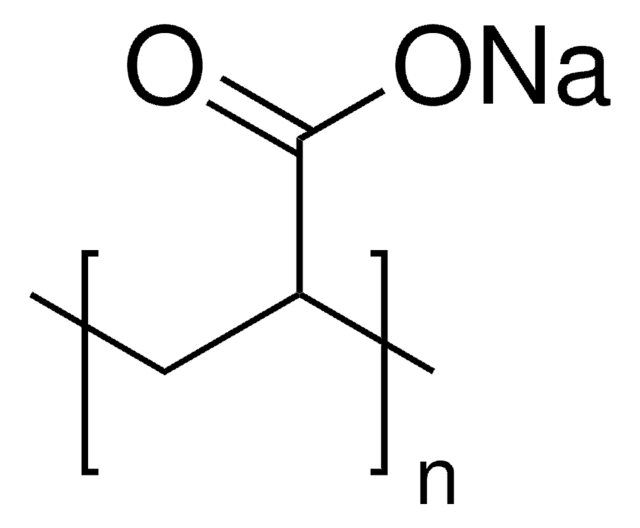436364
Poly(acrylic acid) partial sodium salt
<1000 μm particle size (99%)
Synonym(s):
2-Propenoic acid, sodium salt, polymer with, Acrylic acid-sodium acrylate-1,1,1-trimethylolpropane triacrylate
About This Item
Recommended Products
form
solid
Quality Level
impurities
<600 ppm residual acrylic acid
particle size
<1000 μm (99%)
density
0.69 g/mL at 25 °C (lit.)
InChI
1S/C15H20O6.2C3H4O2.Na/c1-5-12(16)19-9-15(8-4,10-20-13(17)6-2)11-21-14(18)7-3;2*1-2-3(4)5;/h5-7H,1-3,8-11H2,4H3;2*2H,1H2,(H,4,5);/q;;;+1/p-1
InChI key
NZZHEJIHHYZFLN-UHFFFAOYSA-M
Application
- Organobentonites modified with poly (acrylic acid) and its sodium salt for foundry applications: This study investigates the interaction between montmorillonite in bentonite and poly(acrylic acid) as well as its sodium salt, focusing on potential uses in foundry applications (S Cukrowicz et al., 2021).
- Temperature and pH-Dependent Response of Poly(Acrylic Acid) and Poly(Acrylic Acid-co-Methyl Acrylate) in Highly Concentrated Potassium Chloride: This research explores the behavior of linear poly(acrylic acid) and its copolymers in response to temperature and pH changes, relevant for various industrial applications (A Sinek et al., 2020).
- Highly sensitive BEHP-co-MEH: PPV+ Poly (acrylic acid) partial sodium salt based relative humidity sensor: Discusses the development of a composite material for humidity sensors, demonstrating the potential of poly(acrylic acid) partial sodium salt in enhancing sensor performance (M Sajid et al., 2017).
- Head-group effect of surfactants of cationic type in interaction with propoxylated sodium salt of polyacrylic acid in aqueous solution: This article examines how different cationic surfactants interact with the sodium salt of polyacrylic acid, providing insights into the molecular dynamics of these mixtures (ZH Asadov et al., 2017).
- Hybrid dual crosslinked polyacrylic acid hydrogels with ultrahigh mechanical strength, toughness and self-healing properties via soaking salt solution: Focuses on the creation of high-performance hydrogels using polyacrylic acid partial sodium salt, aiming for applications that require materials with advanced mechanical properties (X Li et al., 2017).
Signal Word
Warning
Hazard Statements
Precautionary Statements
Hazard Classifications
Eye Irrit. 2 - Skin Irrit. 2 - STOT SE 3
Target Organs
Respiratory system
Storage Class Code
11 - Combustible Solids
WGK
WGK 1
Flash Point(F)
Not applicable
Flash Point(C)
Not applicable
Personal Protective Equipment
Choose from one of the most recent versions:
Already Own This Product?
Find documentation for the products that you have recently purchased in the Document Library.
Customers Also Viewed
Our team of scientists has experience in all areas of research including Life Science, Material Science, Chemical Synthesis, Chromatography, Analytical and many others.
Contact Technical Service




